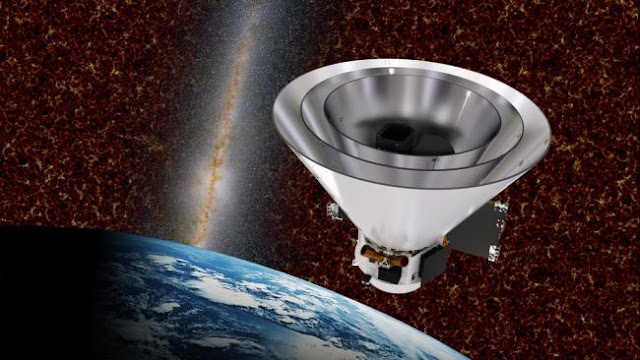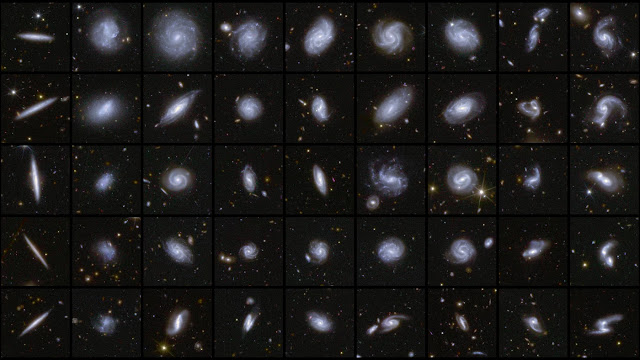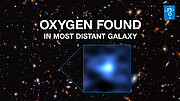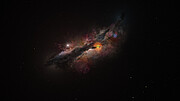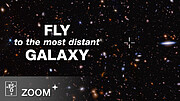Two different teams of astronomers have
detected oxygen in the most distant known galaxy, JADES-GS-z14-0. The
discovery, reported in two separate studies, was made possible thanks to
the Atacama Large Millimeter/submillimeter Array (ALMA), in which the
European Southern Observatory (ESO) is a partner. This record-breaking
detection is making astronomers rethink how quickly galaxies formed in
the early Universe.
JADES-GS-z14-0 is the most distant confirmed galaxy ever found: it is
so far away, its light took 13.4 billion years to reach us, meaning we
see it as it was when the Universe was less than 300 million years old,
about 2% of its present age. The new oxygen detection with
ALMA, a telescope array in Chile’s Atacama Desert, suggests the galaxy is much more chemically mature than expected.
“
It is like finding an adolescent where you would only expect babies,”
says Sander Schouws, a PhD candidate at Leiden Observatory, the
Netherlands, and first author of the Dutch-led study, now accepted for
publication in
The Astrophysical Journal. “
The results show
the galaxy has formed very rapidly and is also maturing rapidly, adding
to a growing body of evidence that the formation of galaxies happens
much faster than was expected."
Galaxies usually start their lives full of young stars,
which are made mostly of light elements like hydrogen and helium. As
stars evolve, they create heavier elements like oxygen, which get
dispersed through their host galaxy after they die. Researchers had
thought that, at 300 million years old, the Universe was still too young
to have galaxies ripe with heavy elements. However, the two ALMA
studies indicate JADES-GS-z14-0 has about 10 times more heavy elements
than expected.
“
I was astonished by the unexpected results because they opened a new view on the first phases of galaxy evolution,”
says Stefano Carniani, of the Scuola Normale Superiore of Pisa, Italy,
and lead author on the paper now accepted for publication in
Astronomy & Astrophysics. “
The evidence that a galaxy is already mature in the infant Universe raises questions about when and how galaxies formed.”
The oxygen detection has also allowed astronomers to make their distance measurements to JADES-GS-z14-0 much more accurate. “
The
ALMA detection offers an extraordinarily precise measurement of the
galaxy’s distance down to an uncertainty of just 0.005 percent. This
level of precision — analogous to being accurate within 5 cm over a
distance of 1 km — helps refine our understanding of distant galaxy
properties,” adds Eleonora Parlanti, a PhD student at the Scuola Normale Superiore of Pisa and author on the
Astronomy & Astrophysics study
[1].
“
While the galaxy was originally discovered with the James Webb Space Telescope, it took ALMA to confirm and precisely determine its enormous distance,”
[2] says Associate Professor Rychard Bouwens, a member of the team at Leiden Observatory. “
This shows the amazing synergy between ALMA and JWST to reveal the formation and evolution of the first galaxies.”
Gergö Popping, an ESO astronomer at the European ALMA Regional Centre who did not take part in the studies, says:
"I
was really surprised by this clear detection of oxygen in
JADES-GS-z14-0. It suggests galaxies can form more rapidly after the Big
Bang than had previously been thought. This result showcases the
important role ALMA plays in unraveling the conditions under which the
first galaxies in our Universe formed."
Notes
[1] Astronomers use a measurement known as redshift
to determine the distance to extremely distant objects. Previous
measurements indicated that the galaxy JADES-GS-z-14-0 was at a redshift
between about 14.12 and 14.4. With their oxygen detections, both teams
have now narrowed this down to a redshift around 14.18.
[2] The James Webb Space Telescope is a joint project of NASA, the European Space Agency (ESA)
and the Canadian Space Agency (CSA).
More information
The teams are composed of:
Italian-led, Astronomy & Astrophysics paper:
Stefano Carniani (Scuola Normale Superiore, Pisa, Italy [SNS]),
Francesco D’Eugenio (Kavli Institute for Cosmology, University of
Cambridge, Cambridge, UK [CAM-KIC]; Cavendish Laboratory, University of
Cambridge, Cambridge, UK [CAM-CavL] and INAF – Osservatorio Astronomico
di Brera, Milano, Italy), Xihan Ji (CAM-KIC and CAM-CavL), Eleonora
Parlanti (SNS), Jan Scholtz (CAM-KIC and CAM-CavL), Fengwu Sun (Center
for Astrophysics | Harvard & Smithsonian, Cambridge, USA [CfA]),
Giacomo Venturi (SNS), Tom J. L. C. Bakx (Department of Space, Earth,
& Environment, Chalmers University of Technology, Gothenburg,
Sweden), Mirko Curti (European Southern Observatory, Garching bei
München, Germany), Roberto Maiolino (CAM-KIC, CAM-CavL and Department of
Physics and Astronomy, University College London, London, UK [UCL]),
Sandro Tacchella (CAM-KIC and CAM-CavL), Jorge A. Zavala (National
Astronomical Observatory of Japan, Tokyo, Japan), Kevin Hainline
(Steward Observatory, University of Arizona, Tucson, USA [UArizona-SO]),
Joris Witstok (Cosmic Dawn Center, Copenhagen, Denmark [DAWN] and
CAM-CavL), Benjamin D. Johnson [CfA], Stacey Alberts [UArizona-SO],
Andrew J. Bunker (Department of Physics, University of Oxford, Oxford,
UK [Oxford]), Stéphane Charlot (Sorbonne Université, CNRS, Institut
d’Astrophysique de Paris, Paris, France), Daniel J. Eisenstein (CfA),
Jakob M. Helton (UArizona-SO), Peter Jakobsen (DAWN and Niels Bohr
Institute, University of Copenhagen, Copenhagen, Denmark), Nimisha
Kumari (Space Telescope Science Institute, Baltimore, USA), Brant
Robertson (Department of Astronomy and Astrophysics University of
California, Santa Cruz, USA), Aayush Saxena (Oxford and UCL), Hannah
Übler (CAM-KIC and CAM-CavL), Christina C. Williams (NSF NOIRLab,
Tucson, USA), Christopher N. A. Willmer (UArizona-SO) and Chris Willott
(NRC Herzberg, Victoria, Canada).
Dutch-led, The Astrophysical Journal paper: Sander
Schouws (Leiden Observatory, Leiden University, Leiden, the Netherlands
[Leiden]), Rychard J. Bouwens (Leiden), Katherine Ormerod (Astrophysics
Research Institute, Liverpool John Moores University, Liverpool, United
Kingdom [LJMU]), Renske Smit (LJMU), Hiddo Algera (Hiroshima
Astrophysical Science Center, Hiroshima University, Hiroshima, Japan and
National Astronomical Observatory of Japan, Tokyo, Japan), Laura
Sommovigo (Center for Computational Astrophysics, Flatiron Institute,
New York, USA), Jacqueline Hodge (Leiden), Andrea Ferrara (Scuola
Normale Superiore, Pisa, Italy), Pascal A. Oesch (Département
d’Astronomie, Université de Genève, Versoix, Switzerland; Cosmic Dawn
Center, Copenhagen, Denmark and Niels Bohr Institute, University of
Copenhagen, Copenhagen, Denmark), Lucie E. Rowland (Leiden), Ivana van
Leeuwen (Leiden), Mauro Stefanon (Leiden), Thomas Herard-Demanche
(Leiden), Yoshinobu Fudamoto (Center for Frontier Science, Chiba
University, Chiba, Japan), Huub Rottgering (Leiden) and Paul van der
Werf (Leiden).
The Atacama Large Millimeter/submillimeter Array (ALMA), an
international astronomy facility, is a partnership of ESO, the U.S.
National Science Foundation (NSF) and the National Institutes of Natural
Sciences (NINS) of Japan in cooperation with the Republic of Chile.
ALMA is funded by ESO on behalf of its Member States, by NSF in
cooperation with the National Research Council of Canada (NRC) and the
National Science and Technology Council (NSTC) in Taiwan and by NINS in
cooperation with the Academia Sinica (AS) in Taiwan and the Korea
Astronomy and Space Science Institute (KASI). ALMA construction and
operations are led by ESO on behalf of its Member States; by the
National Radio Astronomy Observatory (NRAO), managed by Associated
Universities, Inc. (AUI), on behalf of North America; and by the
National Astronomical Observatory of Japan (NAOJ) on behalf of East
Asia. The Joint ALMA Observatory (JAO) provides the unified leadership
and management of the construction, commissioning and operation of
ALMA.
The European Southern Observatory (ESO) enables scientists
worldwide to discover the secrets of the Universe for the benefit of
all. We design, build and operate world-class observatories on the
ground — which astronomers use to tackle exciting questions and spread
the fascination of astronomy — and promote international collaboration
for astronomy. Established as an intergovernmental organisation in 1962,
today ESO is supported by 16 Member States (Austria, Belgium, Czechia,
Denmark, France, Finland, Germany, Ireland, Italy, the Netherlands,
Poland, Portugal, Spain, Sweden, Switzerland and the United Kingdom),
along with the host state of Chile and with Australia as a Strategic
Partner. ESO’s headquarters and its visitor centre and planetarium, the
ESO Supernova, are located close to Munich in Germany, while the Chilean
Atacama Desert, a marvellous place with unique conditions to observe
the sky, hosts our telescopes. ESO operates three observing sites: La
Silla, Paranal and Chajnantor. At Paranal, ESO operates the Very Large
Telescope and its Very Large Telescope Interferometer, as well as survey
telescopes such as VISTA. Also at Paranal ESO will host and operate the
Cherenkov Telescope Array South, the world’s largest and most sensitive
gamma-ray observatory. Together with international partners, ESO
operates ALMA on Chajnantor, a facility that observes the skies in the
millimetre and submillimetre range. At Cerro Armazones, near Paranal, we
are building “the world’s biggest eye on the sky” — ESO’s Extremely
Large Telescope. From our offices in Santiago, Chile we support our
operations in the country and engage with Chilean partners and society.
Links
Contacts:
Stefano Carniani
Scuola Normale Superiore
Pisa, Italy
Tel: +39 050 509156
Email: stefano.carniani@sns.it
Sander Schouws
Leiden University
Leiden, The Netherlands
Email: sanderschouws@gmail.com
Eleonora Parlanti
Scuola Normale Superiore
Pisa, Italy
Email: eleonora.parlanti@sns.it
Rychard Bouwens
Leiden Observatory, University of Leiden
Leiden, The Netherlands
Tel: +31 71 527 8456
Email: bouwens@strw.leidenuniv.nl
Jacqueline Hodge
Leiden Observatory, University of Leiden
Leiden, The Netherlands
Tel: +31 71 527 8450
Email: hodge@strw.leidenuniv.nl
Gergö Popping
European ALMA Regional Centre, European Southern Observatory
Tel: +49 89 3200 6247
Email: gpopping@eso.org
Bárbara Ferreira
ESO Media Manager
Garching bei München, Germany
Tel: +49 89 3200 6670
Cell: +49 151 241 664 00
Email: press@eso.org
